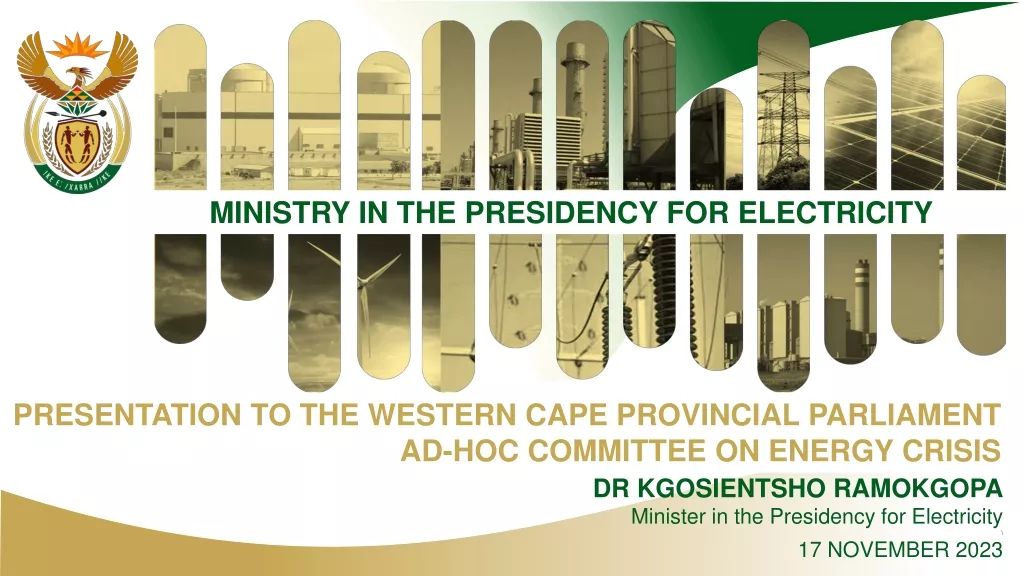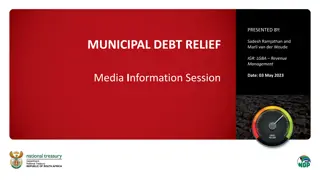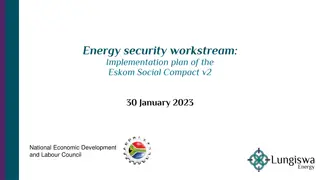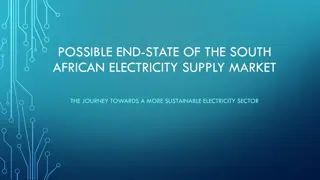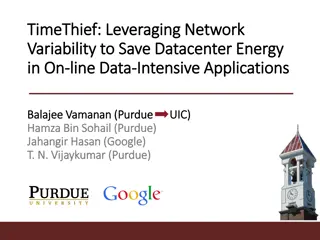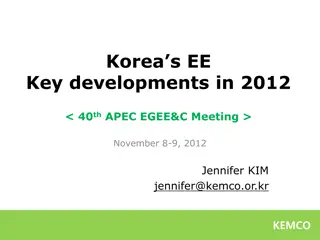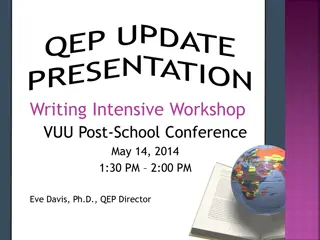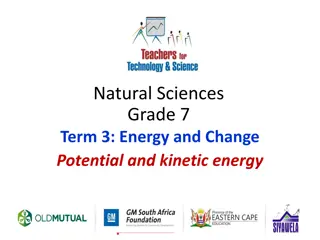Energy Intensive User Group: Challenges Facing Eskom
The Energy Intensive User Group (EIUG) in South Africa represents heavy industries that rely heavily on energy supplied by Eskom. The challenges facing Eskom, such as maintenance neglect, underperformance of new build fleet, inadequate tariff structures, and vast debt burden, pose significant threats to both the supplier and the large consumer groups. Innovative interventions are crucial for ensuring a sustainable electricity supply industry in South Africa.
Download Presentation

Please find below an Image/Link to download the presentation.
The content on the website is provided AS IS for your information and personal use only. It may not be sold, licensed, or shared on other websites without obtaining consent from the author.If you encounter any issues during the download, it is possible that the publisher has removed the file from their server.
You are allowed to download the files provided on this website for personal or commercial use, subject to the condition that they are used lawfully. All files are the property of their respective owners.
The content on the website is provided AS IS for your information and personal use only. It may not be sold, licensed, or shared on other websites without obtaining consent from the author.
E N D
Presentation Transcript
2020 EIUG Views on Operational and Financial Challenges facing Eskom and possible solutions- 4 March 2020
THE ENERGY INTENSIVE USER GROUP WHO WE ARE: Established in 1999, the EIUG is a voluntary, non-profit association of 29 energy intensive consumers whose members currently account for over 40% of the electrical energy consumed in South Africa. Our members collectively contribute over 22% to the GDP of South Africa, employing some 658 000 South Africans with a collective SA turnover of R 685Bn. The EIUG has significant technical expertise on energy matters. It is a respected and non- partisan organisation dedicated to working towards a sustainable electricity supply industry. Key focus for the EIUG is: Quality of Supply - Reliable Supply - Affordable Energy - Internationally competitive energy tariffs that are affordable and sustainable. The EIUG engages with suppliers to ensure that the supply of energy adheres to the prescribed standards. The EIUG is dedicated to working with the relevant stakeholders to ensure the uninterrupted supply of energy. 2
BROAD INTRODUCTION/ BACKGROUND Heavy Industry, specifically Energy Intensive Industry represents a vital element in the consumption of energy supplied by Eskom- not only a large portion of the energy that is consumed, but it is constantly consumed; 24/7/365 in simple commercial terms the basic income of Eskom; While certainly not the only factor in the manufacturing cost account for the industries we represent, it is often the single largest cost element for many in the sector representing 25-30% of the manufacturing cost account the symbiosis is very clear a healthy (reliable) and cost competitive energy supplier is vital to this large industrial sector as much as the base load is essential to Eskom Eskom has clearly faced many significant challenges over the last 1-2 decades. The result is clear stagnating or regressing electricity supply growth, rapidly escalating costs and a clear and growing element of unreliability in supply- these realities are unfortunately enterprise threatening for Eskom and many of the large user group we represent. The consequences for both supplier and large consumer and the South African economy is bleak without far reaching, innovative intervention 3
SOME OF THE SIGNIFICANT PROBLEMS ESKOM FACES Long periods of historical neglect of maintenance has taken its toll on the aging generation fleet age is not seen as a specific issue, but the lack of diligent care and maintenance certainly is (the EIUG is well acquainted with aging equipment and maintenance thereof); The underperformance of the New Build Fleet is a clear and pressing challenge; Clearly an urgent and highly effective maintenance program including a rapid and extraordinarily innovative fix for new-builds is essential but supply cannot adequately cover demand thus very questionable ability to satisfy the fix and supply criteria simultaneously Eskom is in a precarious position with tariff structures that are claimed to be inadequate and with a vast debt burden is no longer a sustainable business and the MYPD methodology can no longer be used to regulate a technically insolvent business Eskom costs are out of control and cost increases as proposed by Eskom cannot be afforded by consumers 4
SOME CAUTIONS While not fully evolved at this stage, the speculated deep maintenance program (ca. 5GW shed for prolonged periods to perform maintenance/ fixes on new-builds) is a very significant fraction of the reliable base load capacity of Eskom (ca 23GW); The Energy Intensive User Group does not outright support such deep load shedding and cautions that while well executed maintenance and fixes are vital the impact of deep load shedding will be extremely injurious to the Energy Intensive Sector and the Economy ; Clearly an urgent and highly effective maintenance program including a rapid and extraordinarily innovative fix for new-builds is essential but supply cannot adequately cover demand thus very questionable ability to satisfy the fix and supply criteria simultaneously Eskom is in a precarious position with tariff structures and maintenance of the depth and extent required which is expensive adequate financial provisioning along with the skilled staff are essential for success- engagements with Eskom around the matter have indicated clear acknowledgement of these aspects- secure, durable solutions are not as evident- certainly needs verification. 5
FURTHER CAUTIONS Currently much of the Energy Intensive Sector is facing various economic hardships with a number of operations in near distress or distress situation (recall the role electricity costs play in these industries); Some in distress have closed down domestic operations (some electing to reposition activities off-shore); Several are undergoing detailed cost-cutting measure and some are in a S189 process in terms of the MHSA Moderate and certainly severe load curtailment, particularly with a large unpredictability factor is considered extremely injurious to the equipment utilized, not to mention the impacts in terms of rising fixed costs for the enterprises Predictability of electricity availability and competitive, predictable pricing is a key element in the survival of this sector 6
SOME POSSIBLE SOLUTIONS On the Cost and Tariff structure side, these are vital and have to be considered in an innovative way, beyond the current tariff structures (in part Eskom, but not only): Current tariffs for large power users contain a significant element of cross subsidies depending on the location and off-take this can be ca. 14% of the cost of electricity; In the face of likely closure of many of these operations are under circumstances that would not yield the subsidy revenue to Eskom, thus alternatives have to be considered and implemented for large power users On the extended maintenance program, the EIUG has offered Eskom assistance in the planning phase so as to coordinate outage periods with major industrial shut-downs this is seen as a key aspect in ensuring disruptive load shedding is minimized; Likely regional and at least partly bi-lateral approach to individual large consumers, the benefits to Eskom, the consumers and the economy are obvious- but this will not make up the full block of indicated load curtailment/ shedding by any means! Some large industrial consumers have offered demand reduction on a longer term basis this has to be considered in the maintenance program that is intended again, close bilateral collaboration is required 7
EIUG RECOMMENDATIONS That NERSA and the relevant departments of Government establish a revised and long term pricing strategy to better ensure the sustainability of the EI sector- this has multiple elements but requires urgent attention, which might well start with an expeditious short term support framework for Eskom to address cost cutting and challenge its developmental mandate to reduce costs while ensuring that effective, sound maintenance and fix programs are adequately funded and achieve the desired results- reliable and cost competitive power supply That the Department of Public Enterprises ensure Eskom restructuring prevents the drain of necessary funding from Transmission and Distribution. 8
Ro livhula Re a leboha Siyabonga Enkosi Ha khensa Siyathokoza Thank you Dankie Re a leboga 9




